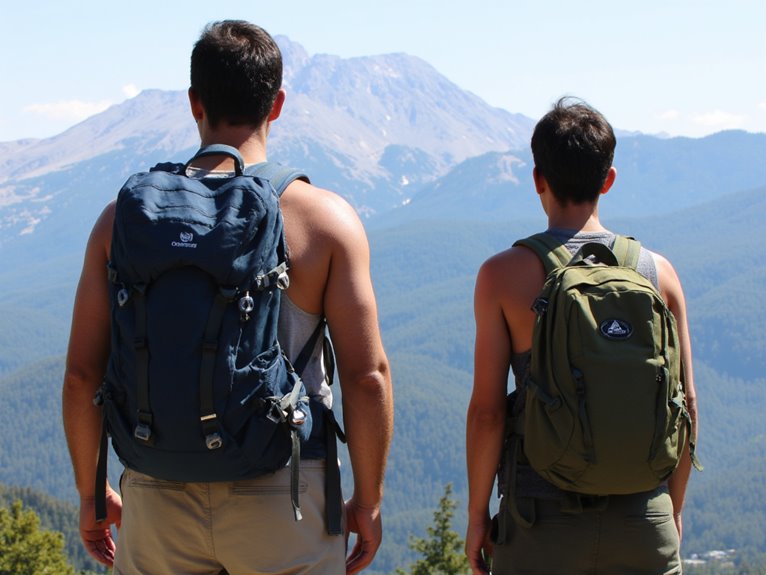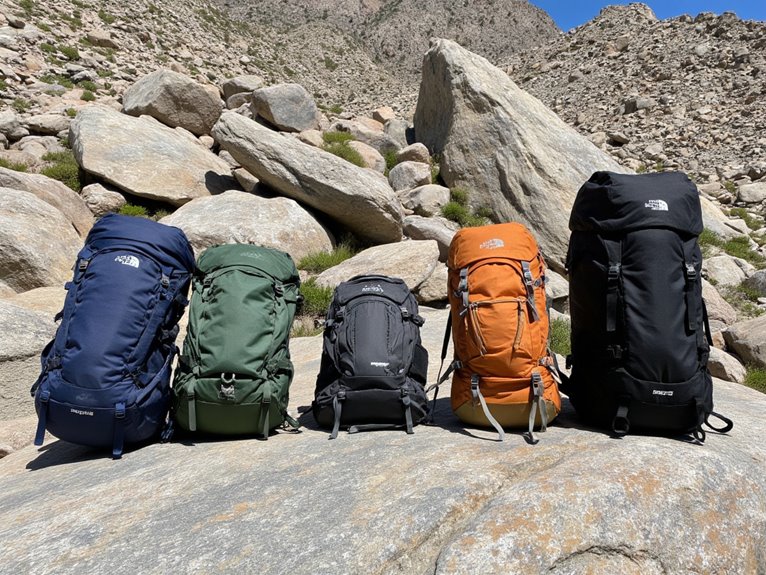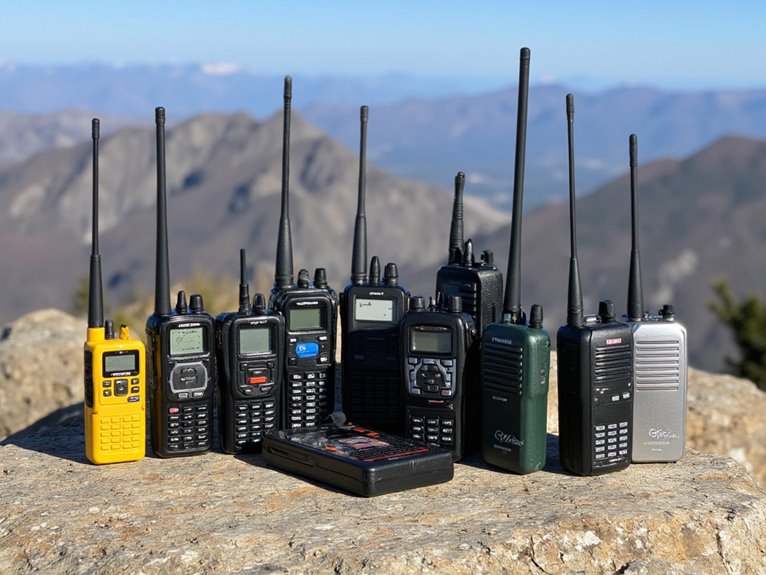What Size Backpack Do You Need?
You’ll need to measure your torso length, not your height, to choose the right backpack size. Torso measurements range from 15-17 inches (small) to 19-21 inches (large). For capacity, day trips require 15-20 liters, overnight camping needs 30-50 liters, and multi-day expeditions demand 50-90 liters depending on conditions. Test packs with 15 pounds of weight to guarantee proper hip belt positioning and strap adjustment. Continue exploring to master the complete fitting process.
We are supported by our audience. When you purchase through links on our site, we may earn an affiliate commission, at no extra cost for you. Learn more. Last update on 7th January 2026 / Images from Amazon Product Advertising API.
Notable Insights
- Measure your torso length (15-17″ small, 17-19″ medium, 19-21″ large) rather than overall height for proper backpack fit.
- Day trips need 15-35 liters, overnight trips require 30-50 liters, and multi-day expeditions demand 50-90 liters capacity.
- Activity type determines size: rock climbing uses under 20 liters while hunting requires 50+ liters for equipment.
- Cold weather conditions need 15-20 liters more capacity than three-season trips due to bulkier gear requirements.
- Test backpacks with 15 pounds of weight to evaluate comfort, suspension systems, and proper hip belt fit.
Understanding Torso Length Vs Overall Height for Backpack Fit

Most hikers make the same critical mistake when selecting a backpack: they choose based on their overall height rather than their torso length. This approach leads to poor fit and discomfort on the trail.
Torso length is the primary measurement for proper pack sizing, not your overall height. Two people standing 5’8″ can have completely different torso measurements-one might need a small pack while the other requires a large.
Manufacturers design their sizing charts around specific torso length ranges, typically categorized as small (15-17 inches), medium (17-19 inches), and large (19-21 inches).
Your height provides general frame reference, but torso length determines where the pack sits on your body. Ignoring this measurement results in improper weight distribution, pressure points, and reduced hiking performance.
A properly fitted backpack should feature padded shoulder straps and adjustable chest belts to complement your torso measurements and ensure optimal comfort during extended hikes.
Measuring Your Torso Length Correctly
Three simple steps will give you an accurate torso measurement for backpack sizing. Proper torso measurement techniques require specific starting and ending points for consistent results.
Accurate torso measurements for backpack fitting depend on precise starting and ending points measured with proper technique.
- Position yourself correctly – Stand straight with shoulders back and feet shoulder-width apart. Wear form-fitting clothing to minimize measurement errors.
- Locate measurement points – Find your C7 vertebra at the base of your neck as the starting point. The ending point is an imaginary line between your thumbs when arms hang naturally at your sides.
- Take the measurement – Use a flexible tape measure following your spine’s natural curves. Keep the tape snug but not tight.
Accuracy factors include consistent posture and having an assistant help you measure twice for verification.
Backpack Volume Basics: Liters and Cubic Inches Explained
Once you’ve determined your proper torso length, understanding backpack volume becomes your next essential step in selecting the right pack.
Backpacks measure volume in liters internationally, though U.S. manufacturers often use cubic inches.
The cubic inch conversion formula is straightforward: multiply cubic inches by 0.016387 to get liters. Conversely, one liter equals approximately 61 cubic inches. For volume calculation from dimensions, multiply length × width × depth in inches, then convert using this factor.
Volume categories range from XS packs at 10-20 liters for day trips to extra-large 85+ liter packs for extended expeditions. Medium backpacks typically span 30-60 liters for overnight adventures.
Understanding these measurements helps you compare packs across different brands and select appropriate capacity for your intended use. To guide your selection, match backpack capacity to your specific trip length: 10-30 liters work perfectly for day hikes, while 40+ liters become necessary for overnight trips.
Daypack Sizing for School, Work, and Short Adventures
While overnight packs demand extensive volume calculations, daypacks require a different sizing approach focused on daily functionality rather than multi-day capacity.
Daypacks range from 15-39 liters, with specific volumes matching distinct use cases. Your capacity needs depend on three primary applications:
- School use: 15-24L accommodates textbooks, laptops, and lunch boxes efficiently
- Work environments: 20-29L provides space for tech devices, documents, and clothing changes
- Short adventures: 25-35L handles water, snacks, rain gear, and navigation equipment
Proper sizing prevents overpacking beyond intended volume, which reduces comfort and damages pack structure. Consider your body size when selecting capacity, as individual proportions influence both comfort and appearance.
Essential daypack features include adjustable padded shoulder straps and breathable back panels. Some models offer specialized features like 180° laptop openings for enhanced accessibility to your tech devices. Organizational pockets segregate items efficiently, whether you’re carrying school supplies or adventure gear.
Choose capacity aligned with your daily cargo requirements.
Overnight and Weekend Trip Backpack Requirements
When you’re planning overnight and weekend trips, your backpack requirements shift dramatically from daypack needs.
You’ll need to evaluate essential volume requirements that range from 30-50 liters depending on trip length, plus additional space for multi-day gear like sleeping systems, shelter, and cooking equipment.
The comfort and fit become critical factors since you’ll be carrying considerably more weight for extended periods, making proper hipbelt support and load distribution essential for your hiking success.
For weekend adventures specifically, the knowledge recommends 40-50L capacity backpacks that provide adequate space for your extended gear while maintaining manageable weight distribution.
Essential Volume Requirements
For overnight and weekend adventures, you’ll need a backpack that can handle considerably more gear than day hiking requires.
The standard volume range of 40-70 liters accommodates essential items like sleeping bags, pads, shelter systems, cooking equipment, and multiple days of food and water.
Most beginners should target 50-60 liters for standard three-season conditions. This capacity handles your core gear without excessive bulk.
Cold weather demands 65-70 liters due to bulkier insulation and clothing layers.
Essential volume considerations include:
- Sleeping system – Your bag and pad consume 15-25% of total pack space
- Food and water – Multi-day provisions require 10-15 liters minimum
- Shelter and cooking gear – Tent, stove, and cookware need organized compartments
When selecting cooking equipment, consider that ultralight stoves like the MSR PocketRocket 2 weigh only 2.6 ounces and fold down to compact 2x2x3 inch dimensions, helping minimize the space dedicated to cooking systems.
Effective Packing Techniques and strategic Gear Organization maximize your pack’s usable volume through compression and systematic placement.
Multi-Day Gear Considerations
Understanding general volume requirements sets the foundation for selecting gear that fits within your pack’s capacity.
Your 40-50 liter weekend pack demands strategic organization to accommodate multiple systems efficiently. Gear compression becomes critical when fitting sleep systems, shelter, and cooking equipment into limited space.
Effective packing strategies involve placing heavy items close to your back’s center and compressing soft gear like clothing into available gaps.
Use compression straps to reduce sleeping bag volume by up to 30%. External attachment points handle bulky items like sleeping pads or tents, freeing internal compartments for organized essentials.
Your cooking system requires dedicated space for stove, fuel, and utensils.
Plan compartment allocation carefully-hydration systems, electronics, and extra layers need accessible positioning. Many backpacks feature dedicated sleeping bag sections that help separate your sleep system from other gear for better organization. Successful weekend trips depend on maximizing every cubic inch through deliberate gear placement and compression techniques.
Comfort and Fit
While gear selection dictates your pack’s volume requirements, the suspension system determines whether you’ll enjoy the journey or endure it. Proper fit transforms a 40-pound load from torture device to manageable cargo.
Your torso length-not height-determines pack size. Measure from C7 vertebra to iliac crest for accurate sizing. Quality packs offer adjustable torso lengths spanning 15-21 inches.
Essential comfort features for pack stability and weight management:
- Padded hip belt – Transfers 80% of load weight from shoulders to hips, reducing fatigue considerably.
- Load lifter straps – Angle pack closer to your back, improving balance and reducing forward pull.
- Sternum strap – Prevents shoulder straps from sliding outward, maintaining ideal load position.
Test your loaded pack before departing. Adjust shoulder straps first, then hip belt, finally load lifters. Proper adjustment creates seamless weight transfer through your body’s strongest muscle groups. For shorter trips where weight is critical, consider that ultralight backpacks can reduce pack weight to under one pound while still providing adequate storage capacity.
Multi-Day and Extended Travel Pack Capacities
When you’re planning trips lasting three days or longer, you’ll need a backpack with at least 50 liters of capacity to accommodate the additional gear, clothing, and supplies required for extended adventures.
The 50–70 liter range serves as the standard for most multi-day backpacking and travel scenarios, providing sufficient space for camping equipment, multiple clothing layers, and food storage without becoming unnecessarily bulky.
Travel-focused packs differ from hiking-specific models in their organizational features and access points, with travel packs prioritizing luggage-style loading and urban functionality over specialized outdoor gear attachment systems.
For shorter excursions, 30-liter backpacks provide an optimal balance of weight and portability for day hikes and brief adventures while maintaining essential comfort features like padded shoulder straps and hydration compatibility.
50+ Liter Capacity Range
Backpacks exceeding 40 liters enter the domain of multi-day and extended travel applications, where capacity becomes critical for carrying extensive gear loads.
These packs accommodate camping equipment, multiple clothing layers, and specialized gear that daypack essentials can’t handle. The 40-70 liter range represents ideal capacity for extended adventures without becoming unwieldy.
Consider these capacity guidelines for multi-day travel:
- 40-50 liters – Weekend backpacking trips with minimal gear
- 50-60 liters – Week-long adventures requiring extensive equipment
- 60-70 liters – Extended expeditions with specialized or winter gear
Packs exceeding 70 liters become impractical for most users. Unlike medium usage applications, these capacities support tents, sleeping systems, cooking equipment, and food reserves.
Volume directly correlates with weight capacity, making proper sizing essential for comfortable extended carrying. When selecting gear for these longer trips, prioritize lightweight tents in the 2-4 pound range to maintain optimal pack weight distribution.
Extended Trip Volume Needs
Extended adventures demand considerably more gear than overnight excursions, pushing volume requirements well beyond the 50-liter threshold into specialized territory. You’ll need 60-80 liters for week-long backcountry trips, accommodating multiple clothing layers, shelter systems, cooking equipment, and food supplies.
Packing efficiency becomes critical at these volumes-compartmentalized designs help organize gear while maintaining quick access to essentials. Proper load distribution through adjustable suspension systems and padded hip belts prevents fatigue during extended wear. Your pack must house the Ten Essentials plus trip-specific equipment like climbing gear or photography tools.
External attachment points optimize internal space usage for bulky items. Choose the smallest adequate capacity to avoid overpacking temptation. Modular features like removable daypacks increase versatility for varied trip profiles while maintaining structural integrity. Extended carrying of heavy packs can stress your feet, so consider quality arch support insoles to prevent discomfort and lower back pain during long treks.
Travel Vs Hiking Requirements
While hiking and travel backpacks share similar capacity ranges, their design priorities diverge considerably based on intended use environments.
These different backpack types must accommodate distinct packing essentials and usage patterns.
Travel backpacks prioritize accessibility through clamshell openings and organizational compartments for electronics, toiletries, and clothing.
You’ll find lockable zippers and laptop sleeves for urban environments.
Hiking packs emphasize load distribution with internal frames, padded hip belts, and hydration compatibility for rough terrain carrying.
For hikers seeking minimal gear options, small hiking backpacks should weigh under 1 pound with capacities of 10-20L and feature packable designs that compress for convenient storage.
Key differences include:
- Weight distribution systems – hiking packs feature robust suspension; travel packs focus on lightweight portability
- Access points – travel packs offer front-loading convenience; hiking packs use top-loading for gear security
- Durability features – hiking packs emphasize weather resistance; travel packs prioritize aesthetic appeal
How Frame Size and Pack Volume Work Independently
When selecting a backpack, you’ll encounter two distinct sizing systems that operate completely independently of each other: frame size and pack volume.
Frame size determines how the pack fits your torso length, ensuring proper frame compatibility with your back measurements. This affects load distribution and comfort regardless of the pack’s storage capacity. A large-frame pack doesn’t necessarily offer high volume, and vice versa.
Pack volume measures storage space in liters, while frame size uses S/M/L designations based on your torso measurements.
You might need a small frame with large volume, or a large frame with minimal capacity. Manufacturers list these specifications separately because they serve different functions.
The frame supports and distributes weight, while volume determines gear capacity. For shorter excursions, 10-15L capacities work well for hikes under four hours, while longer day trips typically require more storage space. Ultralight backpacks typically come in volumes ranging from 30L to 65L, with different sizes serving specific purposes from weekend trips to extended hikes. Choose each independently for ideal fit and functionality.
Testing Backpacks Before You Buy: Key Fitting Tips
Proper backpack fitting requires hands-on testing with weight inside the pack to evaluate how the suspension system distributes load across your body.
Effective backpack testing demands systematic fitting strategies that simulate real hiking conditions. Load approximately 15 pounds into the pack before making any adjustments.
Proper backpack evaluation requires realistic weight distribution testing with weighted loads before finalizing any strap adjustments.
Here’s your essential fitting protocol:
- Initial Setup: Loosen all straps completely, then buckle the hipbelt with padding positioned on your iliac crest.
- Strap Progression: Tighten shoulder straps first, followed by load-lifter straps at 45-degree angles, then sternum strap.
- Load Verification: Verify 80% of weight transfers to your hips while maintaining 1-2 inch shoulder strap anchor points below shoulder tops.
Use mirrors or assistance to verify proper positioning.
Continual fine-tuning during actual use remains normal for best comfort. Consider testing packs with padded laptop compartments if you plan to carry electronic devices during your travels.
Activity-Specific Size Recommendations for Every Need

Since different activities demand vastly different gear loads, selecting the right backpack size depends on matching capacity to your specific adventure requirements.
Day hikes need 10-20 liter packs for hydration and snacks.
Overnight camping requires 20-40 liters to accommodate sleeping bags and cooking gear.
Weekend trips demand 50-65 liters for additional clothing and food supplies.
Extended expeditions necessitate 70-90 liter capacity for weather gear and safety equipment.
Travel backpacks range from 10-35 liters for commuting to over 50 liters for long-term journeys.
Technical activities like rock climbing favor smaller packs under 20 liters to reduce backpack weight and enhance mobility.
Consider your style preferences when choosing between ultralight minimalist designs versus feature-rich options.
Fishing typically requires 20-50 liters, while hunting demands 50+ liters for extended gear loads.
Multi-day adventures perform best with 40L to 60L capacity, where smaller 40L packs suit ultralight trips while larger 50L+ options accommodate bulkier camping equipment for longer excursions.
Frequently Asked Questions
Can I Use a Hiking Backpack for Airline Carry-On Travel?
You can use a hiking backpack for airline travel if it’s 40-50 liters or smaller.
Most airlines restrict carry-ons to 22″ x 14″ x 9″, which eliminates backpacks over 50 liters. External straps and rigid frames may cause problems during boarding.
Compress your pack fully and remove external attachments. Larger hiking backpacks exceeding these dimensions require checked baggage status.
How Much Weight Can My Backpack Safely Hold Without Breaking?
Your backpack’s weight capacity depends on materials durability and construction quality. High-grade nylon and reinforced stitching typically handle 40-60 pounds safely.
However, backpack weight limits for your body matter more than breaking points. You shouldn’t exceed 10% of your body weight for day trips or 20% for multi-day treks.
Quality packs rarely break before exceeding safe carrying limits for your spine and shoulders.
Do Expensive Backpacks Last Significantly Longer Than Budget Options?
You’ll find expensive backpacks typically last 5-10 years versus 1-2 years for budget options.
Quality materials like 1000d Cordura nylon and YKK zippers withstand rigorous durability tests that cheaper alternatives fail.
Premium packs use superior hardware and abrasion-resistant fabrics that maintain structural integrity under heavy loads.
While you’ll pay more upfront, the cost-per-year often favors expensive backpacks for frequent users.
Should I Buy a Larger Backpack to Grow Into Over Time?
You shouldn’t buy a larger backpack to grow into over time.
Oversized backpack capacity encourages overpacking, creating unnecessary weight that strains your body and reduces hiking efficiency.
Choose based on your current future needs, not hypothetical scenarios. A 40-liter pack handles most weekend trips, while 60-liters suits week-long adventures.
Proper fit matters more than extra space you’ll likely never use effectively.
Can Backpack Straps Cause Permanent Shoulder or Back Damage?
Yes, you’ll risk permanent shoulder or back damage from poorly designed backpack straps.
Improper backpack ergonomics causes forward head posture, chronic trapezius pain, and progressive postural asymmetry.
Single-strap bags create dangerous lateral trunk deviations and muscle imbalances.
Poor weight distribution increases spinal torque, leading to long-term musculoskeletal disorders.
Use bilateral straps positioned at T11-T12 vertebrae with loads under 15% bodyweight to prevent permanent damage.
On a final note
You’ve learned that proper backpack sizing depends on torso length, not height, and that volume requirements vary dramatically by activity type. Measure your torso from C7 vertebra to iliac crest for accurate frame sizing. Match capacity to trip duration: 15-30L for daypacks, 40-65L for weekends, 65L+ for extended travel. Remember that frame size and volume operate independently-you’ll need both measurements correct for ideal comfort and load distribution.

